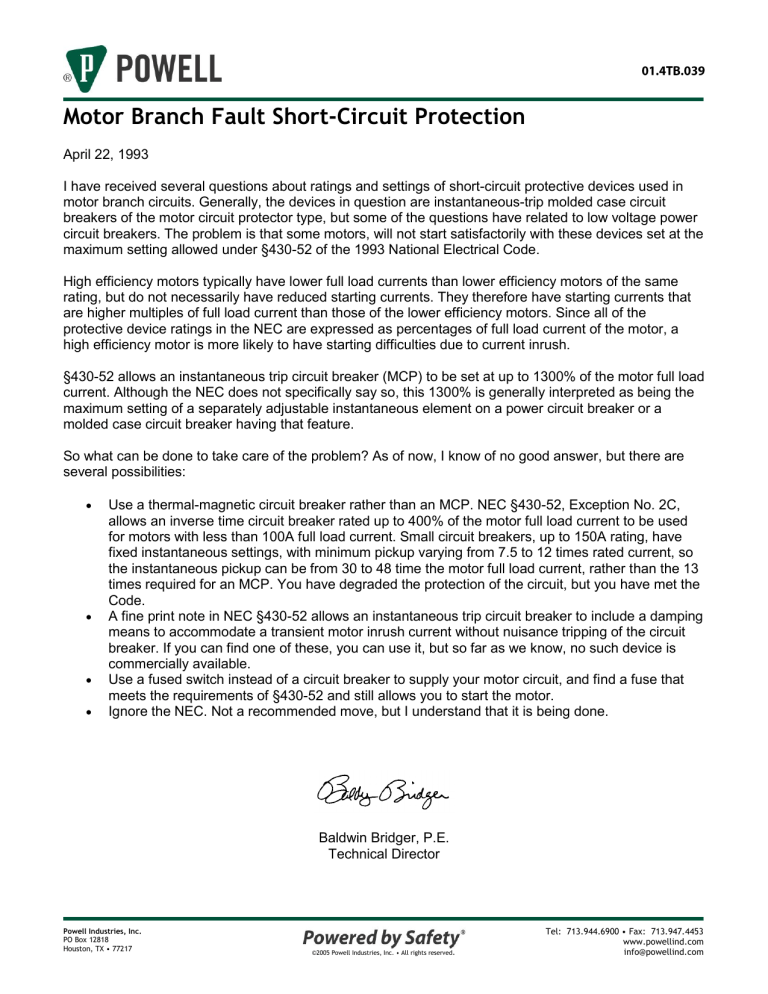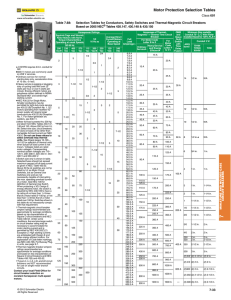Motor Branch Fault Short-Circuit Protection

Motor Branch Fault Short-Circuit Protection
April 22, 1993
I have received several questions about ratings and settings of short-circuit protective devices used in motor branch circuits. Generally, the devices in question are instantaneous-trip molded case circuit breakers of the motor circuit protector type, but some of the questions have related to low voltage power circuit breakers. The problem is that some motors, will not start satisfactorily with these devices set at the maximum setting allowed under §430-52 of the 1993 National Electrical Code.
High efficiency motors typically have lower full load currents than lower efficiency motors of the same rating, but do not necessarily have reduced starting currents. They therefore have starting currents that are higher multiples of full load current than those of the lower efficiency motors. Since all of the protective device ratings in the NEC are expressed as percentages of full load current of the motor, a high efficiency motor is more likely to have starting difficulties due to current inrush.
§430-52 allows an instantaneous trip circuit breaker (MCP) to be set at up to 1300% of the motor full load current. Although the NEC does not specifically say so, this 1300% is generally interpreted as being the maximum setting of a separately adjustable instantaneous element on a power circuit breaker or a molded case circuit breaker having that feature.
So what can be done to take care of the problem? As of now, I know of no good answer, but there are several possibilities:
Use a thermal-magnetic circuit breaker rather than an MCP. NEC §430-52, Exception No. 2C, allows an inverse time circuit breaker rated up to 400% of the motor full load current to be used for motors with less than 100A full load current. Small circuit breakers, up to 150A rating, have fixed instantaneous settings, with minimum pickup varying from 7.5 to 12 times rated current, so the instantaneous pickup can be from 30 to 48 time the motor full load current, rather than the 13 times required for an MCP. You have degraded the protection of the circuit, but you have met the
Code.
A fine print note in NEC §430-52 allows an instantaneous trip circuit breaker to include a damping means to accommodate a transient motor inrush current without nuisance tripping of the circuit breaker. If you can find one of these, you can use it, but so far as we know, no such device is commercially available.
Use a fused switch instead of a circuit breaker to supply your motor circuit, and find a fuse that meets the requirements of §430-52 and still allows you to start the motor.
Ignore the NEC. Not a recommended move, but I understand that it is being done.
Baldwin Bridger, P.E.
Technical Director
Powell Industries, Inc.
PO Box 12818
Houston, TX • 77217
©2005 Powell Industries, Inc. • All rights reserved
.
Tel: 713.944.6900 • Fax: 713.947.4453 www.powellind.com info@powellind.com


